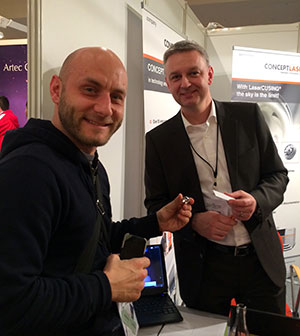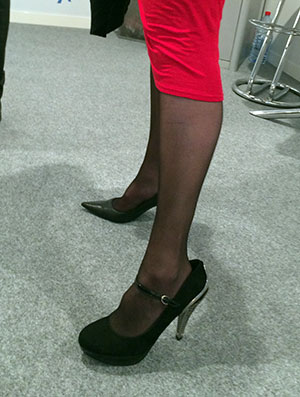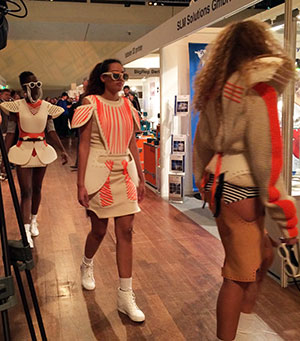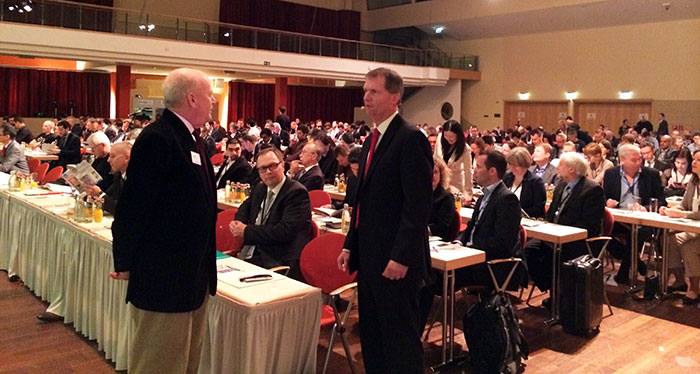Berlin, some call it the hidden capital of Germany, it’s nigh on impossible to get direct flights on a given date and at a given time from the North of England, I know that much. I knew a few other things about the city before my first ever visit for the Inside 3D Printing Berlin event too. Specifically that there used to be a big wall dividing the East and the West of the city, it reportedly had super wide roads and my friend got engaged there a couple of decades ago when her husband-to-be was serving in the military there.
Part of the gloabl Inside 3D Printing road show, Berlin was the first stop in Europe for the international event series. Media Bistro, the organizers, are historically experienced in producing successful shows across a number of sectors — the Internet, Social Media and now Bitcoin among others. They know how to organize and they know about their subjects and believe in them — 3D printing included.
Without fail, exhibitors I spoke to were more than impressed with the organization. Pre-marketing is obviously a strong point too — delegates and networkers were strong in number and quality, 800+ in total. One such comment that backs this up came from Ingo Ederer, CEO of voxeljet, who reported that the “many people that visited out stand were seriously interested, not just expressing a passing interest.”
If you pay to go to an event like this, you have a serious interest. And while shows that incur a registration cost are increasingly losing favour in the US and the UK, we’re talking about largely local markets that are increasingly expecting free information from shows that are held annually and expecting the world to come to them. This obviously includes significant international travel costs for overseas visitors. The Inside 3D Printing series is a different beast altogether — the premise being that it is taking quality information, in the form of comprehensive, locally pertinent conference programmes about 3D printing and additive manufacturing across the world to wholly new demographics of keenly interested parties in their own territory who will pay to attend but don’t have to pay for much else (lunch is included, and at the Estrel Hotel and Conference Centre in Berlin it was delicious).
That said, the Media Bistro representatives reported a 40% international attendance rate to me in Berlin. Corroborated by Marine and Clement at Sculpteo, who told Davide and I that they had spoken with many international delegates, most noticeably from Eastern Europe and further reiterated when I spoke with Fabbster, 3D Systems and iGo3D. Therefore, feel free to shoot my above argument down in flames. The truth is there are arguments for and against paid and free events, a debate that could feasibly continue ad infinitum.
Another interesting breakdown of the attendees at Inside 3D Printing Berlin was conducted by Terry Wohlers at the start of his keynote address on the first morning of the two day event. He asked the packed out room who of them were completely new to 3D printing — roughly a third of the people raised their hands. He looked visibly taken aback, which he corroborated later when I spoke with him, and I concurred. As he asked the same room about longevity in the industry, in 5-year increments, the number of hands reduced as expected, until it was just him at 25+ years. His credentials remain strong and his message, as ever, was clear. Strong growth across industry is set to continue, similarly strong growth in the consumer markets — but via 3D printing services, not personal 3D printers. He covered lots of other things too, all of which was soaked up by the audience and re-quoted over the next two days more than a few times. Standards was another issue Terry touched on, which emerged as a theme at this conference, but we’ll come back to that.
The accompanying exhibition was a constantly busy place with positive reports from the exhibitors. The only real negative was that many 3D printer platforms were lacking somewhat in my opinion, the vendors that had brought working machines were attracting more visitors to their stands than those without. Although in a couple of cases it was not for the want of trying — both 3D Systems and Rapide 3D were subjected to the bureaucracy of German customs. As a result I didn’t get to see the Rapide One or the chocolate 3D printer up close and make Shane jealous! Ethan Hunt, the Australian CEO of Rapide3D, was a stalwart though and even though his concerted attempts to resolve the custom issues proved an impossible mission, he was in good spirits, a true measure of the man!
Part of my own mission on the first day was conducting interviews to camera with some VIPs. It was good fun and gave me the opportunity to catch up with some great people. But as you can imagine it was also quite time consuming. Hopefully you will be able to see the results for yourself on 3DPI.tv and Media Bistro’s website soon enough. Interviewees included Markus Reichlin, CEO of SLM Solutions, Terry Wohlers, Ingo Ederer, Michael Eichmann, CEO of RTC Technologies and Eric Klemp of Paderborn University, who was largely responsible for the programming of the conference and served as an excellent moderator. I also got to interview the inimitable Alan Meckler, CEO of Media Bistro and the man who launched the 3D Printing and Technology Investment fund. Interesting stuff — although, as you might expect, I learned the most interesting things off camera. And, I just might have been persuaded about Bitcoin!
I was privileged to join a lovely group of people for dinner on the first night and shared a taxi with Eric Klemp who was so congenial and amusing, not to mention extremely intelligent, it was hard not to warm to him immediately. He is also working with a young and dynamic, equally intelligent team at Paderborn University. And as a German native Eric had the taxi driver take us on a detour on the way to the restaurant so that I got a glimpse of the small remaining part of the Berlin wall. This was following an earlier conversation that involved a few people bemoaning the fact that international travel generally constituted learning about the airport, hotels and convention centres of country X. Not so for me in Germany on this occasion.
The first drop of my jaw in Berlin occurred quite early on when I literally fell upon the BigRep One (I have a bruised knee to prove it) but more in-depth information here.

The crew from FabLab Berlin reported great interest from across the city, their model is fairly standard within the FabLab genre, whereby it is a workshop hub for makers with entry level manufacturing tools available, including a slew of 3D printers, not least a MakerBot mini. There is also an emphasis on education and inclusion — all supplied with oodles of enthusiasm and a noticeable passion for 3D printing.
Similarly, Dimension Alley recently opened its 3D printer hub and café doors in Berlin. It’s still early days but Norma Barr, co-founder, reported a great deal of interest and a steady stream of people through said doors. Davide is going to head over there later in the week and will report back.

Some of the most beautiful 3D printed pieces on show at the event were from design label Pumundus. I started talking to Christoph Volcker courtesy of him recognizing the designer of the 3D printed necklace I was wearing at the time — Lionel Dean. Christoph wasn’t the only one to recognize it either, which tells me two things — first, Lionel’s stunning work is getting the recognition it deserves and second that it is still quite a small world we’re operating in!
I was so delighted to find out on the eve of the show that Florian Horsh was heading over. I first met him in person at Euromold last year and he made a lasting impression, his flair with and passion for 3D printing has not lapsed any, if anything it has increased. All that said, it was slightly disconcerting when he took off my hat, whipped out a tape measure and started measuring my head. A 3D printed hat is the plan, and once I realized he was following through with what I had assumed was a throw away comment at Euromold I remained composed and nonchalant — not. I’m literally on tenterhooks with anticipation — eek! Florian was accompanied by Ulrike Hemmann whom it was a great pleasure to meet. She is part of the organization putting together RapidTech , another German 3D printing show later in the year. It was also in the company of these fine people that I was introduced to Antonious Koster and Anna Wilhelmi.
[nggallery id=155]Antonius was actually the source of another jaw dropping moment, he regaled his captivated audience with a new dental application he has been involved with via his consultancy business (design/scanning/3D printing) and told us how both 3D scanning and 3D printing technologies are being used in new ways to improve dental services.
In a nutshell it comes down to patients going to a dentist with toothache that requires extraction. It is now possible to have the bad tooth CT scanned, root and all. The scan data can then be used to produce an accurate digital 3D model of the tooth and root, which is subsequently 3D printed using SLS with a dental approved material. This 3D printed replica of the tooth then replaces the bad tooth at the time of extraction. Sounds pretty painful, right, but so awesome too!
Antonius was also presenting at the conference, his main focus on a case study centred around the designs of student Anna Wilhelmi. The full story will not fit here and I want to do it justice so it will follow in the next day or so. But here’s a taster — her collection was modeled during the networking evening ….

I’ve already waffled far more than I intended so I’ll avoid going into specific presentations based on my copious notes and settle for picking up on a few key themes that emerged.
Standards was the big one — the need for them across all sectors of the 3D printing industry, but the strongest calls for consolidation in this area came from the big OEMS — Scott Martin of Boeing was vocal on the matter during his presentation and Martin Schaeffer of Siemens dedicated his whole presentation to the subject. As did Rainer Gebhardt from VDMA. Many others mentioned it too.
Another theme was, of course, hype. The general context for this was in terms of managing expectations of costs versus capability and differentiating clearly between the entry level 3D printers and those at the other end of the spectrum. I lost count of the number of times the Gartner hype cycle appeared on the slides of different presenters. All showing “consumer” 3D printing right on the crest of the curve, while “enterprise” 3D printing (I obviously didn’t get the memo on when AM/industrial 3D printing was switched for this new moniker!) was half way up the slope to adoption and acceptance.
There was also the issue of the size of the market, it was rife, but while the situation is a case of asking 20 people what the size of the market is, and getting 20 different answers, I’m steering clear of that one. The widespread consensus though, in general terms, was that the 3D printing market is a tiny fraction of the vast market for traditional manufacturing techniques. It was sobering and useful in this context, but positive too in that there is huge potential and exciting times ahead.
And that leads me nicely into “the future” — quite a few presentations were based on what is coming next, often contextualized with when, where, why and how. Clever future mapping, trend optimisation and some serious research produced intricate graphs and projection strategies. As for me, I’m with Prof Frederic Thiesse, Professor of Information Systems Engineering at Julius Maximilian’s Univeristy of Wurzburg, who said: “Ultimately, nobody knows.” I nearly cheered out loud. Fortunately I managed to restrain myself!
So, to sum up what I am taking home from Inside 3D Printing Berlin (apart from an owl and a new phone cover – thank you Marine) it was an excellent and exhilarating event, tailored to Germany, with HUGE interest from German and Eastern European markets, but with a global context. To me it demonstrated how a B2B event model can successfully be converged with B2C — essentially reflecting the 3D printing industry itself. The need for consistent and consolidated standards is a big concern, as is hype and managing expectations. The future can take care of itself, and with the wonderful work that is happening right now with 3D printing — right across the board — I don’t doubt that it will.
In terms of where Inside 3D Printing is going next, the second New York edition will take place in a couple of weeks, during the first week of April, returning once again to the Javits Centre. Subsequently, the show is heading to Brazil, South Korea, Hong Kong, Japan, Milan, Australia, China (Shanghai) and Singapore.




